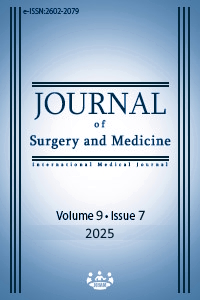Stacked hybrid model: Multi-layer perceptron and logistic regression with meta-learning for cesarean section classification
Hybrid model for C-section prediction
Keywords:
cesarean prediction, clinical decision support, medical data analysis, machine learning in healthcareAbstract
Background/Aim: This study aims to develop an interpretable and practical decision support method for early prediction of the need for cesarean delivery. Although machine learning and deep learning models are prevalent in the literature, their generalization capabilities are often restricted, especially when utilizing small clinical datasets. This limitation underscores the necessity for robust, transparent, and well-regularized models in medical decision-making processes.
Methods: The study proposed a stacking-based hybrid model, which combines the strengths of both classical and modern techniques. The data were normalized using StandardScaler, and feature selection involved principal component analysis (PCA) and SelectKBest to capture global and target-relevant patterns. In the classification phase, two parallel learners – a regularized multi-layer perceptron (MLP) and logistic regression – were used, followed by a random forest meta-learner.
Results: The experimental analysis demonstrated that the proposed model achieved an average accuracy of 96.43% under stratified 5-fold cross-validation. Although this result surpassed the performance of other baseline models within the dataset, it should be regarded as preliminary due to the limited sample size.
Conclusion: The findings indicate that the proposed hybrid approach has potential as a promising direction for future clinical decision support research. Nonetheless, additional validation using larger and more diverse datasets is necessary to adequately assess its generalizability and practical utility.
Downloads
References
Afroja S, Kabir MA, Saleh AB. Machine learning-based algorithms for determining C-section among mothers in Bangladesh. Int J Travel Med Glob Health. 2023;11(4):391-401. doi: 10.34172/ijtmgh.2023.65.
Chu K, Cortier H, Maldonado F, Mashant T, Ford N, Trelles M. Cesarean section rates and indications in sub-Saharan Africa: a multi-country study from Médecins Sans Frontières. PLoS One. 2012;7(9):e44484. doi: 10.1371/journal.pone.0044484. DOI: https://doi.org/10.1371/journal.pone.0044484
Desyani T, Saifudin A, Yulianti Y. Feature selection based on Naive Bayes for caesarean section prediction. IOP Conf Ser Mater Sci Eng. 2020;879(1):012091. doi: 10.1088/1757-899X/879/1/012091 DOI: https://doi.org/10.1088/1757-899X/879/1/012091
de Souza HC, Perdoná GS, Marcolin AC, Oyeneyin LO, Oladapo OT, Mugerwa K, et al. Development of caesarean section prediction models: secondary analysis of a prospective cohort study in two sub-Saharan African countries. Reprod Health. 2019;16:1-11. doi: 10.1186/s12978-019-0832-4. DOI: https://doi.org/10.1186/s12978-019-0832-4
Pereira S, Portela F, Santos MF, Machado J, Abelha A. Predicting type of delivery by identification of obstetric risk factors through data mining. Procedia Comput Sci. 2015;64:601-9. doi: 10.1016/j.procs.2015.08.572. DOI: https://doi.org/10.1016/j.procs.2015.08.573
Amir75. Caesarean Section Classification Dataset [Internet]. Kaggle; [cited 2025 April 14]. Available from: https://www.kaggle.com/datasets/amir75/caesarean-section-classification/data
Hosmer DW Jr, Lemeshow S, Sturdivant RX. Applied Logistic Regression. 3rd ed. Hoboken (NJ): John Wiley & Sons; 2013. DOI: https://doi.org/10.1002/9781118548387
Rigatti SJ. Random forest. Journal of Insurance Medicine. 2017;47(1):31-9. DOI: https://doi.org/10.17849/insm-47-01-31-39.1
Desai M, Shah M. An anatomization on breast cancer detection and diagnosis employing multi-layer perceptron neural network (MLP) and convolutional neural network (CNN). Clin eHealth. 2021;4:1-11. doi: 10.1016/j.ceh.2020.12.001 DOI: https://doi.org/10.1016/j.ceh.2020.11.002
Toğaçar M, Ergen B. Processing 2D barcode data with metaheuristic based CNN models and detection of malicious PDF files. Appl Soft Comput. 2024;161:111722. doi: 10.1016/j.asoc.2023.111722 DOI: https://doi.org/10.1016/j.asoc.2024.111722
Hochreiter S, Schmidhuber J. Long short-term memory. Neural Comput. 1997;9(8):1735-80. doi: 10.1162/neco.1997.9.8.1735 DOI: https://doi.org/10.1162/neco.1997.9.8.1735
Khan NI, Mahmud T, Islam MN, Mustafina SN. Prediction of cesarean childbirth using ensemble machine learning methods. In: Proceedings of the 22nd International Conference on Information Integration and Web-based Applications & Services; 2020 Nov; pp. 331-339. doi: 10.1145/3428757.3429136 DOI: https://doi.org/10.1145/3428757.3429138
Yimer NB, Mekonnen EG. Development and validation of a risk prediction model for caesarean delivery among multiparous women. Sci Rep. 2025;15(1):5326. doi: 10.1038/s41598-025-12990-9 DOI: https://doi.org/10.1038/s41598-025-86015-w
Downloads
- 390 517
Published
Issue
Section
How to Cite
License
Copyright (c) 2025 Emre Yalçın, Hayriye Tanyıldız, Serpil Aslan, Süleyman Cansun Demir, Mesut Avan, Fatma İşlek Uzay, Serdar Aykut
This work is licensed under a Creative Commons Attribution-NonCommercial-NoDerivatives 4.0 International License.
















